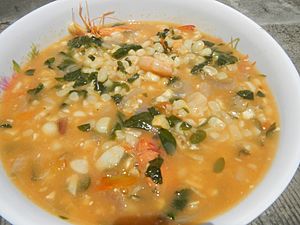Suam na mais facts for kids
 |
|
| Alternative names | suam mais, sinuwam na mais, suwam na mais, ginisang mais, sinabawang mais |
|---|---|
| Course | Soup |
| Place of origin | Philippines |
| Region or state | Pampanga. |
| Serving temperature | Hot |
| Main ingredients | corn, beef/shrimp, leafy vegetables, onion, garlic, salt, pepper |
Suam na mais is a delicious and comforting Filipino soup. It is made mostly with fresh corn and different kinds of leafy greens. You might find it with moringa leaves, bitter melon leaves, or Malabar spinach leaves. This soup also often includes pork or shrimp to make it even more flavorful.
Suam na mais comes from the province of Pampanga in the Philippines. People often enjoy this warm soup during the rainy season. It is also known by other names like ginisang mais in the Tagalog language and sinabawang mais in the Visayan languages.
Contents
What's in Suam na Mais?
Suam na mais is special because of its main ingredients.
Sweet Corn
The star of the soup is corn. Filipino cooks often use fresh, young corn. They scrape the kernels off the cob or even mash some of them. This gives the soup a naturally sweet taste and a slightly thick texture.
Leafy Greens
Different green vegetables are added to the soup. These greens make the soup healthy and add a fresh taste.
- Malunggay: This is also known as moringa. It is a very common and healthy leaf in the Philippines.
- Ampalaya: This is bitter melon. Its leaves can be used, giving the soup a unique, slightly bitter flavor that many people enjoy.
- Alugbati: This is Malabar spinach. It adds a slightly slimy texture and a mild taste.
Protein and Flavor
To make the soup more filling, meat or seafood is often included.
- Shrimp: Many versions of suam na mais use fresh shrimp. The shrimp adds a savory, seafood flavor to the broth.
- Pork: Sometimes, small pieces of pork are used instead of or along with shrimp.
- Aromatics: Onions and garlic are always used. They are sautéed (cooked quickly in oil) first to build the base flavor of the soup. Salt and pepper are added to taste.
Where Does Suam na Mais Come From?
Suam na mais has its roots in Pampanga, a province located north of Manila in the Philippines.
Pampanga: The Culinary Capital
Pampanga is famous for its delicious food. It is often called the "Culinary Capital of the Philippines." Many traditional Filipino dishes come from this region. The people of Pampanga, known as Kapampangans, are very proud of their cooking skills. They have passed down recipes like suam na mais through many generations.
A Dish for All Seasons
While often enjoyed during the rainy season for its warmth, suam na mais is a comforting dish that can be eaten any time of the year. It is a simple yet satisfying meal that highlights fresh, local ingredients.
How is Suam na Mais Made?
Making suam na mais is quite straightforward.
Cooking Steps
- Sautéing: First, onions and garlic are cooked in a pot until they are soft and fragrant. This step builds the flavor base.
- Adding Protein: If using shrimp or pork, they are added next and cooked until they change color.
- Corn and Water: The corn kernels (and sometimes some mashed corn) are added to the pot. Then, water or broth is poured in. The mixture is brought to a boil and then simmered until the corn is tender.
- Greens and Seasoning: Finally, the leafy vegetables are stirred in and cooked just until they wilt. Salt and pepper are added to taste. Some people might also add a little fish sauce for extra flavor.
Why is Suam na Mais Popular?
This soup is loved by many Filipinos for several reasons.
Comfort Food
Suam na mais is a warm and soothing soup. It is especially popular during the cooler, rainy months because it helps to warm you up. It feels like a hug in a bowl!
Healthy and Filling
With fresh corn and lots of green vegetables, it is a healthy meal. The added protein from shrimp or pork makes it a filling dish that can be eaten on its own or with rice.
Simple and Delicious
The flavors of suam na mais are simple but very satisfying. The natural sweetness of the corn blends well with the savory broth and the fresh taste of the greens. It is a great example of how delicious Filipino home cooking can be.

